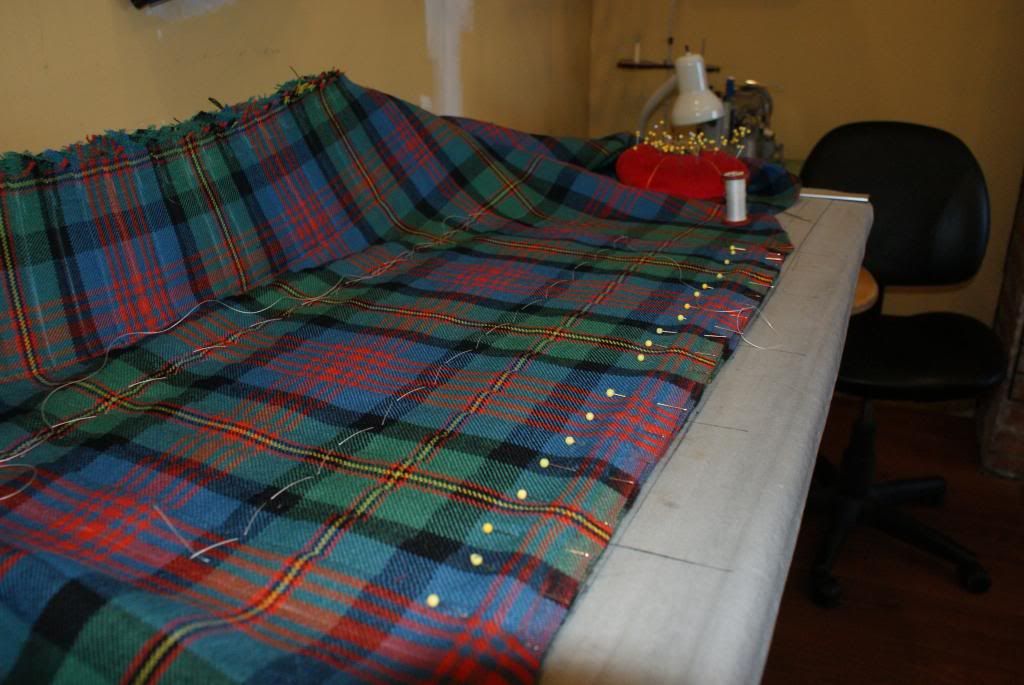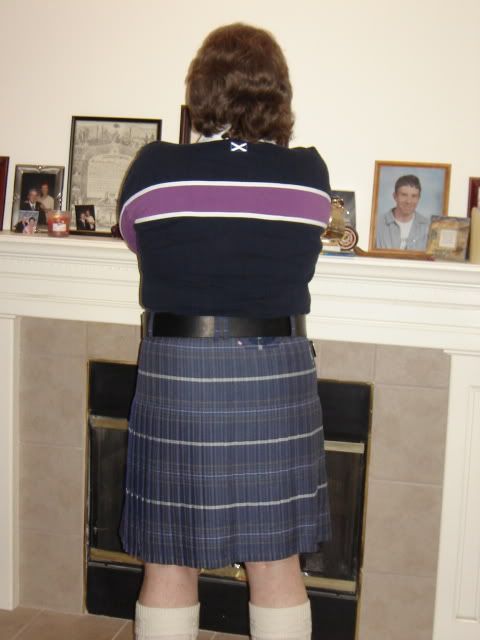|
-
30th April 16, 09:31 PM
#1
Help with unkempt pleats
This is a cheaper kilt I admit, but it is supposed to be wool. I'm dissatisfied with the pleats. I have tried running the iron over it on low with a towel as a barrier, but that did not seem to do any good. Any other suggestions?
Attachment 27901
Thanks,
NPG
-
-
30th April 16, 10:40 PM
#2
You can try using a hand steamer if you have one, if not it may cost you as much as you paid for the kilt. Seriously there isn't much you can do.
You can try also pressing it from the inside - that may help a bit. One of the problems with the low yardage kilts is that the pleats aren't very deep and are prone to becoming very wrinkled every time you sit on them. It can help to use a scarf or a belt to hold the pleats in place when you get in and out of a car. Some of what is advertised as wool is a blend of wool and other materials and it doesn't hold a crease the same as wool. True poly viscose seems to be pretty good, but the "PV" from Pakistan has issues. While acrylic doesn't wrinkle and feels somewhat like wool it pills badly and doesn't hold a crisp crease very well.
Just my observations. Take them for what they are worth.
"Good judgement comes from experience, and experience
well, that comes from poor judgement."
A. A. Milne
-
The Following 2 Users say 'Aye' to Liam For This Useful Post:
-
30th April 16, 10:54 PM
#3
 Originally Posted by Liam

You can try using a hand steamer if you have one, if not it may cost you as much as you paid for the kilt. Seriously there isn't much you can do.
You can try also pressing it from the inside - that may help a bit. One of the problems with the low yardage kilts is that the pleats aren't very deep and are prone to becoming very wrinkled every time you sit on them. It can help to use a scarf or a belt to hold the pleats in place when you get in and out of a car. Some of what is advertised as wool is a blend of wool and other materials and it doesn't hold a crease the same as wool. True poly viscose seems to be pretty good, but the "PV" from Pakistan has issues. While acrylic doesn't wrinkle and feels somewhat like wool it pills badly and doesn't hold a crisp crease very well.
Just my observations. Take them for what they are worth.
Liam,
Thank you, I will give some of these a try. This was advertised as 100% wool, but I have a bad feeling I've been misled. The pleats were not great when I first got it, but after a few moves they've just gotten worse. I'm planning to make a kilt this summer using The Art of Kiltmaking as my guide. Maybe I'll remake this one from some proper kilting wool.
-
-
30th April 16, 11:07 PM
#4
OK first of all, we do not iron the pleats of a kilt. We press them with high heat and a lot of pressure. That is what sets the creases.
But first -- and this is the most important part. You baste the pleats into their correct position first. Basting is one of those things that everyone hates and avoids at first. Now, I actually like basting.
The advantage of basting over pinning is that you can press right down on and over the basting without leaving the bumps that pins leave.
With a tape measure find the width of the pleat up at the bottom of the Fell (this is the hip line or the bottom of where the pleats are sewn down and tapered.)
You are looking at two things. You want your crease to go straight down and follow the Tartan pattern. If a line is a certain distance from the edge of the pleat up at the Fell it must be the same distance from the edge of the pleat all the way down to the hem.
And the width of each pleat must be the same all the way from the Fell down to the hem. The cross section of the pleated part of a kilt is a section of a cylinder.
You baste to keep the Tartan pattern straight down each pleat and the width of each pleat the same from Fell to hem.
Once the pleats are basted (and you use as many horizontal lines of basing stitches as necessary to hold the pleats in position.) the kilt will no longer lay flat. The Fell area must be lifted or draped over the edge of your pressing table with the pleats perfectly straight, flat and smooth.
This is what a basted kilt looks like ready to press. (note - the single line of pins at the hem is where I am putting the final line of basting stitches.)

Notice that the hem line is now a straight line and not a curve.
Now to press the creases.
You need an iron that is set to the wool setting and that can create steam. It is the heat provided by the steam and not the heat of the iron's sole plate that softens the wool fibers.
You will need a pressing cloth (a pillow case works well) or a teflon protective sole plate on your iron.
NEVER PUT YOUR HOT IRON DOWN IN DIRECT CONTACT WITH YOUR EXPENSIVE WOOL!
Spritz your pressing cloth to create more steam.
You do not move the iron back and forth. You place the iron down on your pressing cloth. The heat of the iron only creates steam.
As the wool fibers soften you will see the pleats start to lay down flatter. Then get right up on top of the iron and press straight down to set the creases.
Then pick the iron straight up, move to a new spot and set it straight back back down to create more steam and set the next area of pleat creases.
In the back of a well pressed kilt all the pleats should hang straight and parallel without any shower curtain waves.

Steve Ashton
www.freedomkilts.com
Skype (webcam enabled) thewizardofbc
I wear the kilt because: Swish + Swagger = Swoon.
-
The Following 6 Users say 'Aye' to The Wizard of BC For This Useful Post:
-
30th April 16, 11:29 PM
#5
Wizard of BC,
Thanks! I'll see if I can figure this stuff out. I'll have my fiancée help me she knows about basting the pleats she says.
-
-
The basting is the most important part and by the way, very few dry cleaners understand this process, so even if you're going for some horrid reason to take your kilt there, baste it yourself before you take it.
Rev'd Father Bill White: Mostly retired Parish Priest & former Elementary Headmaster. Lover of God, dogs, most people, joy, tradition, humour & clarity. Legion Padre, theologian, teacher, philosopher, linguist, encourager of hearts & souls & a firm believer in dignity, decency, & duty. A proud Canadian Sinclair with solid Welsh and other heritage.
-
The Following 3 Users say 'Aye' to Father Bill For This Useful Post:
-
If you find that after careful pressing you still do not get a sharp crease you might resort to using a lightweight hemming tape - this is a last resort - well - maybe penultimate, you could always sew them, but if you get some hemming tape, you need a strip about 1/4 of an inch wide, then a board to press on - some sturdy cardboard with an old pillow slip will do. It need only be as long as from the lower edge of the fell to the lower edge of the kilt.
Carefully pin the tape into the fold of the visible crease of a pleat getting the fold exactly right, and then gently heat to activate the glue on the tape. Use a small pressing cloth, and perhaps covering the closest part of the kilt with a towel to protect it from the heat and the iron, just in case the description was inaccurate. If you avoid the pins and do the in between parts, remove the pins and then press where they were you should find that you have a neat permanently straight fold. Work slowly and carefully - this is something best done right the first time.
Try not to stretch the edge, don't iron, just a light pressure, so the fabric is left in as close to its natural state as possible.
Don't be tempted to use a heavyweight tape, you want to alter the properties of the fabric as little as possible except for creating a neat fold.
Anne the Pleater
I presume to dictate to no man what he shall eat or drink or wherewithal he shall be clothed."
-- The Hon. Stuart Ruaidri Erskine, The Kilt & How to Wear It, 1901.
-
The Following 2 Users say 'Aye' to Pleater For This Useful Post:
-
Thank you all, it sounds like I have a few options to try before giving up on this old kilt. I appreciate your expertise very much.
-
The Following User Says 'Aye' to NPG For This Useful Post:
-
Once you get the pleats back in shape, If it's wool, just hanging it in the bathroom while you shower should take care of ordinary wrinkles.
-
The Following User Says 'Aye' to pbutts For This Useful Post:
-
29th May 16, 10:48 PM
#10
 Originally Posted by NPG

Thank you all, it sounds like I have a few options to try before giving up on this old kilt. I appreciate your expertise very much.
What he said! This thread alone is going to save me a lot of money and wasted time in taking proper care of my kilt.
-
 Posting Permissions
Posting Permissions
- You may not post new threads
- You may not post replies
- You may not post attachments
- You may not edit your posts
-
Forum Rules
|
|






















Bookmarks